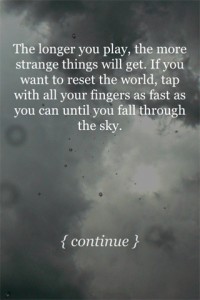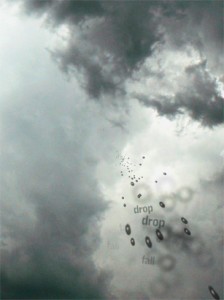STRANGE RAIN is a new iphone/ipad application (aka “app”) by Erik Loyer at opertoon.com that, simply, simulates looking through “a skylight on a rainy day.” Rain falls from the cloudy abyss “above” the viewer to splatter down on the glass of the device. Tilt the device and the atmosphere tilts back, too, maintaining a 3-dimensional appearance that makes it genuinely feel like you are looking up through a portable, handheld window into a sky. You can make gestures with your fingers and cause the rain to gather into a column that follows your fingertips. You can tap on the glass and make music…and words begin to flash in “whispers” beside the raindrops…or, if set to “story” mode, the words appear in complete phrases, in errant but profound micro-musings, evoking a narrative (see Holly Willis’ review at KCET for a description of the ‘story’). The game encourages interactive finger-tapping and dragging as it plays musical notes with each touch. Tap quickly, and you “fall in” to the sky, as the clouds above become framed by other clouds…and still more frames of clouds, cascading and creeping in around the edge of the screen, frame inside of frame inside of frame….
It’s a very mellow, hypnotic kind of 21st century phantasmagoria. Words can’t describe it as well as the sample video on their website:
Strange Rain Preview from Erik Loyer on Vimeo.
The app is quite simple, even monotonous to a degree, but it seems to be surprisingly popular for what amounts to an interactive haiku (Apple featured it in their Entertainment category, and it hit #1 on Jan 14th). I usually don’t buy these kinds of “eye candy” sorts of things, but there are times when it’s worth it to just kick back and relax with a computer/device and see where the muse takes you. There’s something very “zen” about this sort of application — and as Fast Company points out in their review, there are already a host of other “ambient meditation aids” out there in the ipad/iphone market — and we’ve also had New Media Poetry and other forms of Electronic Literature for decades now — but there’s more to the attraction than its successful application of this genre on the ipad platform. On his blog, the app’s author, Erik Loyer, once referred to this approach to gaming as prompting “casual significance” — taking “a stab in the dark, doing things you’d like to build theories around but shouldn’t, and as such they enable you to walk into the unknown with joy and confidence.” Creative minds need to do that. But that wasn’t the entire draw for me: when I read the description of the app, I immediately noticed how it employed the language of the uncanny, and had to give it a try:
Strange Rain…feels as if you’re holding a living window in your hands. The more you touch, however, the more strange the rain becomes: layered skies, visual anomalies and shifts in speed and color, even the occasional cataclysm if you’re not careful. Before your eyes and beneath your fingers, the familiar becomes strange, and the strange, familiar.
Any reader of Freud would recognize the opposition of the familiar and strange as unheimlich — and it is precisely the tropes of the uncanny, rendered interactive (“beneath your fingers”), which make this “living window” so curiously appealing.

Though the game subtly plays off our instinctive “sky is falling” kind of fear, virtual rainfall in itself is not so disturbing. Yet the effect is uncanny. In a review at iphonefreak.com, Andy Boxall compares the app to a David Lynch film, and in the process nails the reason why: “The oddness comes not only from the appearance of the rain falling from inside your device upwards, but from the discordant tunes you can make while tapping the screen.” Let’s talk about these two elements — the visual and the aural — to probe into what makes this app so “strange.”
In Strange Rain, the world is rendered topsy-turvy because we are so habituated toward thinking that the sky is always fixed in a position up above us. Gravity is a natural law for us. Click on this app with an ipad down on your lap or desktop, and suddenly the world has been turned upside-down, fostering a minor sense of acute weightlessness. “Rain” still “falls” in a natural way, but it does not so much fall down on you as fall at you. This feels a bit threatening, sure, and the inversion of our perspective on the world is felt as threatening because it challenges our sense of mastery over the environment. But that threat is offset by a larger fantasy of control over the environment, too: we can “magically” manipulate — nay, orchestrate — the rain with our fingertips. And who hasn’t wanted to control the weather? Or, to quote the game’s tutorial, “reset the world”?
Yet at the same time, the glass is a persistent barrier in this relationship, and the use of cascading frames as you probe deeper into the game persistently reminds the player that the window remains a medium that enables this “control” but at the same time blocks the user from really ever touching or feeling the water and other elements implied by the game’s diegesis. This is why the music — a pling-plongy waltz of notes that change tempo when you tap — is so important, “framing” the experience as an aesthetic one, set to a soundtrack in the foreground, while the “ambient” sound of rainfall is pushed sonically into the background. Diegetic and extra-diegetic elements compete in a way that render the familiar elements of nature (rainstorm/sky) strange (mediated by sounds/images/words). There is a play, too, between what is pre-programmed and what is randomized by the user, as well as between the inescapability of gravity vs. the mobility of the app, which generates oppositional tension: the game flip-flops the fantasy of mastery over the environment with the feeling that the environment is master over the user.
Perhaps the oppositional tensions I have been describing are a common structural element to most interactive handheld games, but the aesthetic framing of this one explicitly puts such issues in the context of a subjective fantasy about the natural environment, where “thoughts” are projected directly onto the sky. I am reminded of the way we often imagine we see uncanny shapes (animals, faces) in random cloud formations. The uncanny is never really just about “scary” objects, but about the projective fantasies we have that seem to “come to life” with more power than we imagine they might have. Strange Rain dramatizes this fantasy in a contemplative and mesmerizing way.
Visit Erik Loyer’s “Generous Machine” site for more of his projects, which include interactive comics and other ‘virtual windows.’
Strange Rain was also recently reviewed in-depth by CNN, who raises the question, “What exactly is it?” The answer: a postmodern phantasmagoria of the popular uncanny.

What a superb app – it perfectly captures the feeling a grey Sunday with nothing better to do than chase raindrops down a window.
Thanks for sharing the link!
I downloaded this app a week or so ago and have been mesmerized. The music is lovely and is what really sells it for me. I find it’s a great app to have on the background while I work. Love the review… thank you!
After reading your essay, I had to get this ap and try it. It’s kind of like a virtual House of Leaves with its swirling letters and infinite hallway. I love how it keeps changing, too. It’s mesmerizing. Also, good ambient sound for working.